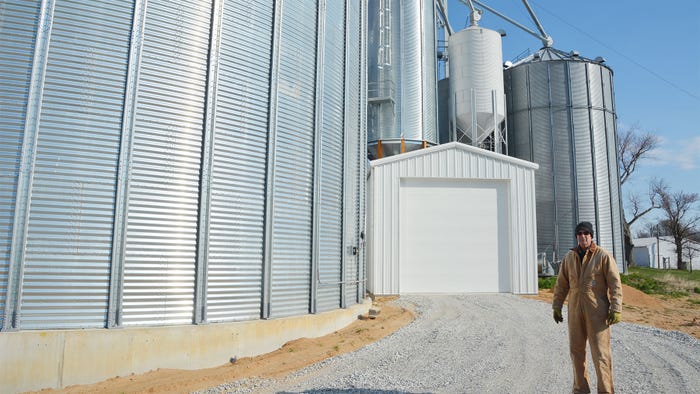
At a Glance
- This farmer determined two specific goals he wanted to accomplish with a grain center expansion.
- He wanted to add grain storage capacity and set the stage for future generations.
- He wanted to restructure the setup so he could dump trucks more quickly.
Tom Nugent, Elnora, Ind., made do with a grain center erected roughly 30 years ago for a long time. When it was clear his son Thomas would be farming for the long haul, Nugent decided to invest in a serious grain center expansion.
In his late 60s, Nugent pulled the trigger very late in 2022, committing to invest in an expansion project with a price tag north of $1 million.
“I had two main goals: adding bushels of storage capacity and adding a larger pit so we could unload and get back to the field faster,” he says.
Right move
Nugent accomplished both goals. The new grain bin holds 145,000 bushels, plus the new wet holding hopper tank holds 10,000 bushels. They can dump a full semiload of corn or soybeans into the pit in a matter of minutes and be off to the field again.
“The large pit probably looks like a Cadillac-type system, but I wanted to be sure we could unload quickly so we could keep the combine moving in the field, and not have it waiting on trucks,” Nugent explains. “With 1-foot-thick walls, it took a lot of concrete, but I am confident that it was done right and will last over the long haul.”
Nugent doesn’t hesitate when asked if he’s glad he pulled the trigger and enlarged the grain system. “Yes, I am very glad I did,” he responds. “I should have done it at least five years sooner, and it would have been cheaper. But material prices aren’t going down, and it would have been more expensive if I waited another five years.”
Grain flow
Because the new 145,000-bushel bin wasn’t finished until the 2023 season was almost over, the Nugents didn’t get a true test of how it would perform during harvest. However, they did fill the bin with dry corn later, and it passed its inaugural test.
This fall, grain coming out of the field that needs drying will dump into the new pit, travel up the new leg into the wet holding bin, and then enter the dryer. “The grain from my dryer unloads into the older leg,” Nugent says. “From there, it is spouted to the GSI VersaLoop conveyor that takes it to the top of the new bin.”
Nugent notes that the VersaLoop is rated at only 4,000 bushels per hour, and that is the rated unload speed of the dryer, too.
“We have an ammeter on it so we can make sure we don’t overload it if we use it to transfer corn from another bin,” he says. “I don’t anticipate running many bushels through the loop, only during drying season.”
One factor in Nugent’s planning was that they typically dry far fewer bushels today than in the past.
“Looking at the big picture, thanks to tiling we have done here that helps us plant earlier, which in turn leads to dryer corn in the field in the fall, it shortens the drying season,” Nugent explains. “Or it allows us to plant slightly longer-season varieties with higher yield potential.”
Drying fewer bushels per season allowed Nugent to extend the life of their current dryer.
“We will need to upgrade it at some point, but not now,” he says. “Our priorities were storage capacity and faster unloading from the field.”
Highlights of new grain system
Here are key points about Nugent’s grain center expansion project:
More storage capacity. They added a 145,000-bushel bin that is 60 feet in diameter and 15 rings tall, plus a 10,000-bushel wet holding tank that is 18 feet in diameter and 16 rings tall.
Large pit. The new pit is 30 feet long, 10 feet wide and 12 feet deep, with two U-trough 16-inch augers. It holds about 1,300 bushels, which is more than a semiload.
Overhead doors. The main part of the L-shaped building over the unloading pit is 34 by 20 feet, with doors on automatic openers on each end. “If we had built the building 4 feet longer, the door tracks would not be offset, but it is not a big deal,” Nugent says.
Lighting for unloading. Lights inside the pit help reduce shadows that would occur when unloading semis at night. There are also pairs of LED lights on each side of the pit partway up the shed walls, but below the height of the overhead doors when open.
Bucket elevator and tower. Partly due to where bins were located and partly for more strength, Nugent opted for a tower to support the bucket elevator instead of a traditional guy-wire arrangement. The tower is 12 by 12 feet and 121 feet tall. The bucket elevator extends below ground level to the bottom of the pit, reducing degree of incline needed on augers. Nugent believes that will extend wear life.
Grain monitoring and aeration. Nugent opted to install the GSI GrainVue automatic grain aeration controller. Linked to weather instruments at the bin site, it aerates grain when necessary. Seven temperature cables inside the new bin report temperature at 4-foot intervals within the grain mass. Moisture cables are also an option.
Cost for this system was about 1% of total cost of the project. There is also a $200-per-year subscription fee so data reaches the cloud. Data and graphs can be viewed on devices, including iPhones, from anywhere.
“The controller is a no-brainer,” Nugent says. “You can program a preferred moisture range for it to operate, and one can re-wet grain and gain bushels. It is more economical for larger bins, and occasionally you may have to replace a cable. But it also offers peace of mind.”
About the Author(s)
You May Also Like




